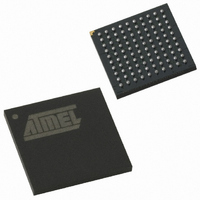AT89C51SND2C-7FTUL Atmel, AT89C51SND2C-7FTUL Datasheet - Page 37

AT89C51SND2C-7FTUL
Manufacturer Part Number
AT89C51SND2C-7FTUL
Description
IC 8051 MCU FLASH 64K MP3 100BGA
Manufacturer
Atmel
Series
89Cr
Datasheet
1.AT89C51SND2C-7FTUL.pdf
(242 pages)
Specifications of AT89C51SND2C-7FTUL
Core Processor
8051
Core Size
8-Bit
Speed
40MHz
Connectivity
I²C, IDE/ATAPI, MMC, SPI, UART/USART, USB
Peripherals
Audio, I²S, MP3, PCM, POR, WDT
Number Of I /o
32
Program Memory Size
64KB (64K x 8)
Program Memory Type
FLASH
Ram Size
2.25K x 8
Voltage - Supply (vcc/vdd)
2.7 V ~ 3.3 V
Data Converters
A/D 2x10b; D/A 2x20b
Oscillator Type
Internal
Operating Temperature
-40°C ~ 85°C
Package / Case
100-TFBGA
Data Bus Width
8 bit
Data Ram Size
2.25 KB
Interface Type
ATAPI, I2S, IDE, SPI, UART, USB
Maximum Clock Frequency
40 MHz
Number Of Programmable I/os
32
Number Of Timers
2
Maximum Operating Temperature
+ 85 C
Mounting Style
SMD/SMT
Minimum Operating Temperature
- 40 C
Lead Free Status / RoHS Status
Lead free / RoHS Compliant
Eeprom Size
-
Lead Free Status / Rohs Status
Details
Other names
AT89C51SND2C7FTUL
Available stocks
Company
Part Number
Manufacturer
Quantity
Price
Company:
Part Number:
AT89C51SND2C-7FTUL
Manufacturer:
ATMEL
Quantity:
4 371
- Current page: 37 of 242
- Download datasheet (3Mb)
9. Interrupt System
9.1
4341H–MP3–10/07
Interrupt System Priorities
The AT8xC51SND2C, like other control-oriented computer architectures, employ a program
interrupt method. This operation branches to a subroutine and performs some service in
response to the interrupt. When the subroutine completes, execution resumes at the point where
the interrupt occurred. Interrupts may occur as a result of internal AT8xC51SND2C activity (e.g.,
timer overflow) or at the initiation of electrical signals external to the microcontroller (e.g., key-
board). In all cases, interrupt operation is programmed by the system designer, who determines
priority of interrupt service relative to normal code execution and other interrupt service routines.
All of the interrupt sources are enabled or disabled by the system designer and may be manipu-
lated dynamically.
A typical interrupt event chain occurs as follows:
•
•
•
•
Table 9-1.
Six interrupt registers are used to control the interrupt system. 2 8-bit registers are used to
enable separately the interrupt sources: IEN0 and IEN1 registers (see Table 9-4 and Table 9-5).
Four 8-bit registers are used to establish the priority level of the different sources: IPH0, IPL0,
IPH1 and IPL1 registers (see Table 9-6 to Table 9-9).
Each of the interrupt sources on the AT8xC51SND2C can be individually programmed to one of
four priority levels. This is accomplished by one bit in the Interrupt Priority High registers (IPH0
and IPH1) and one bit in the Interrupt Priority Low registers (IPL0 and IPL1). This provides each
interrupt source four possible priority levels according to Table 9-2.
Signal
Name
KIN0
INT0
INT1
An internal or external device initiates an interrupt-request signal. The AT8xC51SND2C,
latches this event into a flag buffer.
The priority of the flag is compared to the priority of other interrupts by the interrupt handler.
A high priority causes the handler to set an interrupt flag.
This signals the instruction execution unit to execute a context switch. This context switch
breaks the current flow of instruction sequences. The execution unit completes the current
instruction prior to a save of the program counter (PC) and reloads the PC with the start
address of a software service routine.
The software service routine executes assigned tasks and as a final activity performs a RETI
(return from interrupt) instruction. This instruction signals completion of the interrupt, resets
the interrupt-in-progress priority and reloads the program counter. Program operation then
continues from the original point of interruption.
Type
I
I
I
Interrupt System Signals
Description
External Interrupt 0
See section "External Interrupts", page 40.
External Interrupt 1
See section “External Interrupts”, page 40.
Keyboard Interrupt Input
See section “Keyboard Interface”, page 204.
AT8xC51SND2C/MP3B
Alternate
Function
P3.2
P3.3
-
37
Related parts for AT89C51SND2C-7FTUL
Image
Part Number
Description
Manufacturer
Datasheet
Request
R

Part Number:
Description:
DEV KIT FOR AVR/AVR32
Manufacturer:
Atmel
Datasheet:

Part Number:
Description:
INTERVAL AND WIPE/WASH WIPER CONTROL IC WITH DELAY
Manufacturer:
ATMEL Corporation
Datasheet:

Part Number:
Description:
Low-Voltage Voice-Switched IC for Hands-Free Operation
Manufacturer:
ATMEL Corporation
Datasheet:

Part Number:
Description:
MONOLITHIC INTEGRATED FEATUREPHONE CIRCUIT
Manufacturer:
ATMEL Corporation
Datasheet:

Part Number:
Description:
AM-FM Receiver IC U4255BM-M
Manufacturer:
ATMEL Corporation
Datasheet:

Part Number:
Description:
Monolithic Integrated Feature Phone Circuit
Manufacturer:
ATMEL Corporation
Datasheet:

Part Number:
Description:
Multistandard Video-IF and Quasi Parallel Sound Processing
Manufacturer:
ATMEL Corporation
Datasheet:

Part Number:
Description:
High-performance EE PLD
Manufacturer:
ATMEL Corporation
Datasheet:

Part Number:
Description:
8-bit Flash Microcontroller
Manufacturer:
ATMEL Corporation
Datasheet:

Part Number:
Description:
2-Wire Serial EEPROM
Manufacturer:
ATMEL Corporation
Datasheet:











